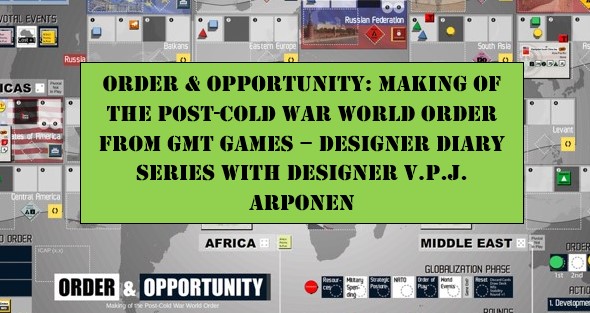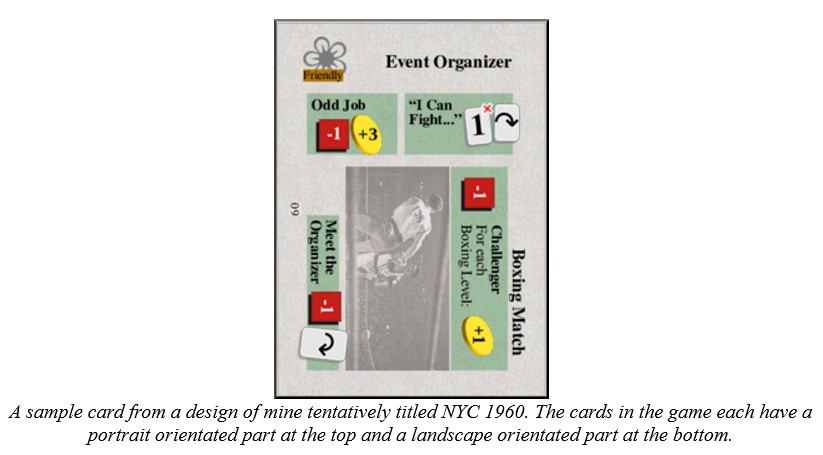We have been following the exploits of a newer designer V.P.J. Arponen over the past several years since his very unique entry into the COIN Series called All Bridges Burning broke in 2019. Since that time, he has been working on his new game called Order & Opportunity, which was announced by GMT Games in February 2023 and takes a look at the post-Cold War world order set in the first decades of the 21st century with the major powers of the United States, Russia, China and the EU controlling the direction of the agenda. Since that time, we have hosted an interview with Vez and also highlighted some of the cards in the game with our Event Card Spoilers Series.
If you are interested, you can check out that interview at the following link: https://theplayersaid.com/2023/08/21/interview-with-v-p-j-arponen-designer-of-order-opportunity-from-gmt-games/
If you missed the Event Card Spoiler entries covering the game, you can catch up on the posts to date by following the below links:
#12 War on Terror/Operation Enduring Freedom
#43 Belt & Road Initiative/Dependencies Created
#15 Intelligence Reform and Terrorism Prevention Act
Recently, Vez reached out to see if we would be interested in hosting a Designer Diary Series where he would go into the background on the design and how it has progressed over the past year. Of course we were interested and are excited to share the following with our readers.

My game Order & Opportunity: Making of the Post-Cold War World Order is currently available for preorder with GMT Games. In these design diary entries I will be writing about various design choices that were made while developing the game over the past several years.
In this entry we continue the discussion of the card design process.
From Ops Points to Suits
Faced with the design challenge about hidden information in a four player CDG as described in the previous entry to this design diary, I found myself thinking about how four-player games involving cards overcome the problem.
Games like Root came to mind (Leder Games 2018). The cards in Root have a suit and one of a relatively small range of possible event effects. I redesigned the cards in Order & Opportunity according to the same principles. Each card now had one of four suits, each suit enabling the execution of one or more specific actions corresponding to the suit. Each card also had an event effect. This is the card structure the game has today still.
So far so good. Having switched to suits, I quickly realized that in the classic CDG card design, one central advantage of the cards having ops points is that they give players flexibility in how they can use their cards. Have you drawn a hand of event effects that don’t really help you? Okay, no problem, just play a card for its ops points and choose the actions you want to do.
By contrast, in a card system in which each card has a single suit and where that suit is tied to a specific action or actions, the players are generally less flexible should they draw an unsuitable hand of cards.



After some experimentation, ultimately no single solution to this problem was ever developed in Order & Opportunity. Rather, in the game as it stands, the problem sort of fades away due to a number of contextual game play features.
One such a feature is that in Order & Opportunity the players can alter the suit composition of their decks as they play (“deck building”). Also, it actually makes some sense to “specialize” and try to make your deck heavy in one or two suits and weaker in others. After each round of play, players may remove one card from their hand-discard-deck cycle and/or include one new card in the mix. Having a “bulldozer” deck that continuously, from round to round, churns out cards of certain suits can be powerful. Still, given the Consequences mechanic we spoke about in the previous article, whereby excessive play of suits of a single card yields certain negative “consequences”, a bulldozer deck will also throw up problems.
Reactions
One problem did remain, namely, that in a four player game the input that any single player had on the game state during their turn could be upturned by the mass of the three other players’ turns that followed before it was the first players turn again.
The answer to my worries came from something else that I was working on at the time — I still have the game, in the drawer, waiting for the right time and place to come out.
I had developed the idea of a loosely historical solitaire game about this Bob Dylan-like figure coming to New York City in the 1960’s trying to make it in “show biz”, or die trying. The Coen Brothers’ film from 2013, Inside Llewyn Davis, perfectly captures the mood I was going for.
That game features cards with a dual structure: in the portrait orientation each card represents a person that our Bob Dylan has encountered in the city while in the landscape orientation the card shows a location. In that game, you hold the persons in your hand as a hand of cards, while as locations the cards are placed onto the table for the player meeple to walk into and visit.

It occurred to me that I could perhaps use a similar structure with the Order & Opportunity cards. In the players’ hands the cards would be used to launch actions per the card’s suit and event effects as detailed in the event text. Alternatively, the cards could be placed onto the map in which case they would function as “reaction abilities” allowing the players to respond to other players’ actions outside of their own turn.
Not only did this introduce a nice decision point for the players as to how to best use a card, but it also gave players more control of the board state outside of their turn.
I predict that the role of the Reaction mechanic will be one of the more difficult things about the game for players to wrap their heads around. After all, players of historical CDG’s are used to playing their cards for the ops points or for the event, not to place them onto the map for a later effect. Still, to me, the Reaction mechanic is something I am very proud of and that I think elevates the game.
If you missed the previous parts in the series, you can catch up at the following links:
Part 2: Representing the Forces From Within

If you are interested in Order & Opportunity: Making of the Post-Cold War World Order, you can pre-order a copy for $55.00 from the GMT Games website at the following link: https://www.gmtgames.com/p-1027-order-opportunity.aspx
-Grant